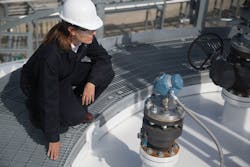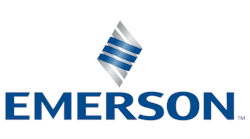Radar has become the preferred technology for level measurement in many of today’s industrial applications since it has been continually developed and improved over the past 40 years (see Image 1). For noncontacting radar instruments, selecting the microwave frequency transmitted by the device is an area in which some interesting recent developments have taken place. Noncontacting radar instruments using high-frequency (75 to 85 gigahertz [GHz]) technology have been introduced, complementing the low- (6 to 11 GHz) and mid-frequency (24 to 29 GHz) devices already extensively deployed to provide accurate and reliable level measurements. Offering a wider selection of devices to end users is beneficial, but it is crucial to select a radar instrument that uses the most appropriate frequency band for each application. The different frequency bands are not equally suited to every application, so the strengths and weaknesses of each must be carefully considered in light of how various process conditions can affect performance.
How frequency affects measurement accuracy
Radar instruments emit microwaves to measure the distance to a surface, calculating distance by the time required for the pulse to hit the surface and reflect back. As with all electromagnetic transmissions, the wavelength is inversely proportional to the frequency — the shorter the wavelength, the higher the frequency. Frequency is a fundamental property of any radar instrument since it directly affects measurement performance in various ways. For instance, high-frequency microwave signals are absorbed to a greater degree when propagating through a medium, so the signal return is weaker (see Figure 1). Just think of music sounding from behind a wall: The high-frequency treble range is not heard, but the low-frequency bass can penetrate through the wall. In level measurement applications, high-frequency radars are more adversely affected by challenging process conditions such as those with condensation, vapor, foam and dust, which again affect the signal return and subsequent accuracy.
Figure 1. When propagating through a medium, radar signals are absorbed and the signal strength decreases. High-frequency signals suffer more attenuation than low- and mid-frequency signals.
Frequency also has an impact on the radar device antenna’s beam width and beam angle. High-frequency signals can enable small beam angles using small antennas. A small beam angle is beneficial because it helps avoid obstructions in tanks and vessels. Low-frequency radars can also achieve small beam angles, but they need larger antennas, so a user needs to consider what fitting sizes are available on the relevant vessels. At the same time, a narrow beam has its own drawbacks. An obstruction in the tank could completely block a narrow beam, while a wider beam might be only partially blocked and could still produce a reliable measurement.
Turbulence within the process liquid can also affect radar level measurement because the microwaves hitting waves and ripples on the surface can scatter and disperse instead of reflecting back to the antenna. Up to 90 percent of the signal strength can be lost this way, affecting the accuracy and reliability of measurements. The short wavelengths associated with high-frequency transmissions are particularly affected.
Application suitability
Many radar level measurement applications exist in the process industries. Each application presents its own challenges, so it is important to consider which frequency band or bands is best suited to solving a given problem. Some examples are:
Dirty and contaminating applications — Dirt and contamination that build up on the antenna over time affects the strength and direction of the radar signal. Low- and mid-frequency signals are less sensitive to this contamination and can pass through the buildup unaffected. However, with high-frequency signals, any dirt covering the antenna absorbs more of the energy, and the direction of the beam may also be diverted. A deposit of uneven thickness covering part of the antenna can redirect the beam by about 1.5 degrees. For a radar with a narrow beam angle, this can cause problems because the return echo will not be directed straight back at the antenna, leading to loss of signal strength. Low- and mid-frequency technology is therefore more suitable.
Tanks with condensation and/or vapor — Condensation and vapor can cause the reflection from the product surface to be obscured by "noise" from water droplets. This is more of a problem for high-frequency signals, so low- and midfrequency technology is a better choice. However, it should be noted that for condensation, the design of the antenna is also critically important. Antennas with flat, horizontal surfaces should always be avoided in these applications.
Applications with turbulence, waves and ripples — Waves and ripples are often present on the surface of a process liquid in large tanks, and such turbulence is especially detrimental to high-frequency measurements. The short wavelength of high-frequency devices means that the signal reflection will be scattered by small surface movements, causing loss of returning signal strength. Low- and mid-frequency level instruments emit longer wavelengths, enabling them to perform better.
Applications with foam — Just like dirt and condensation, a layer of foam on top of the liquid will absorb the radar signal and make accurate measurement more difficult. Foam from different products can have extremely different properties, but lower-frequency instruments generally provide better measurement accuracy and reliability. For dense and thick foam, such as from beer, molasses or latex, low-frequency works best. For lighter foam, mid-frequency performs well. High-frequency technology, though, should be avoided in foamy applications.
Bulk liquid storage tanks — Many bulk storage vessels use floating roof tanks, requiring level measurements to be performed through still-pipes. Low-frequency radars are preferred for these applications because they are less sensitive to buildup on the pipe wall in addition to slots and pipes that are not completely straight. High-frequency radars have difficulties in such situations. Furthermore, bulk storage tanks often have significant roof movements caused by sunlight and shade, wind and tank bulging. This causes problems for high-frequency radars because their narrow beam width makes them sensitive to tilting (see Figure 1). If the axis moves from the vertical plumb line, the reflected signal may miss the antenna opening.
Small- to medium-sized vessels — These tanks, typically up to 20 meters (m) high, often provide challenging conditions such as condensation, contamination, turbulence and foam. Midfrequency technology is a good choice in this kind of tank since it combines small antennas with good reliability. Low-frequency radars may be less suitable because of problems fitting larger antennas into the small nozzles common on these vessels, while high-frequency technology is less able to cope with tough process conditions.
Small tanks/buckets — In small tanks about 0.5 to 1.5 m high, the size and placement of nozzles can be a limitation. The short measuring range and the need for small antennas means that high- and mid-frequency technologies are attractive options for these applications. However, as previously mentioned, challenges such as condensation, contamination, turbulence and foam must be considered where applicable.
Solids — For measuring the level of solids, the best frequency depends on the application. Low and mid-frequencies can cope with dust, condensation and coarse solids. High frequencies work well with fine powders. Condensation is generally challenging for high-frequency radars, but with solids yet another problem arises: Condensation in combination with certain types of solids causes rapid material buildup. This can quickly clog small nozzle openings and cover the small antennas of high-frequency radars.
In summary
Frequency band selection is a vital consideration when deciding which noncontacting radar devices are the best options for each different level measurement application. Radars using the recently introduced 75-to-85-GHz frequency range are a good choice for tanks with small process connections, but if connection size is not a limiting factor, low- and mid-frequency radar instruments are much better equipped to provide accurate and reliable level measurement in even the most demanding industrial applications.
Andreas Hessel is strategic product manager for Rosemount Process Level Radar Instrumentation at Emerson in Gothenburg, Sweden. For more information about noncontacting radar, visit emerson.com/rosemount-level.



